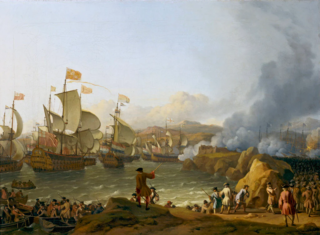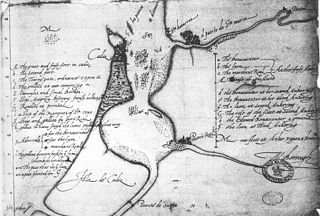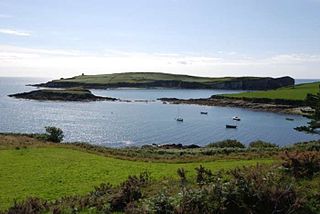
Galleons were large, multi-decked sailing ships first used as armed cargo carriers by European states from the 16th to 18th centuries during the age of sail and were the principal vessels drafted for use as warships until the Anglo-Dutch Wars of the mid-1600s. Galleons generally carried three or more masts with a lateen fore-and-aft rig on the rear masts, were carvel built with a prominent squared off raised stern, and used square-rigged sail plans on their fore-mast and main-masts.

The Battle of Vigo Bay, also known as the Battle of Rande, was a naval engagement fought on 23 October 1702 during the opening years of the War of the Spanish Succession. The engagement followed an Anglo-Dutch attempt to capture the Spanish port of Cádiz in September in an effort to secure a naval base in the Iberian Peninsula. From this station the Allies had hoped to conduct operations in the western Mediterranean Sea, particularly against the French at Toulon. The amphibious assault, however, had proved a disaster, but as Admiral George Rooke retreated home in early October, he received news that the Spanish treasure fleet from America, laden with silver and merchandise, had entered Vigo Bay in northern Spain. Philips van Almonde convinced Rooke to attack the treasure ships, despite the lateness of the year and the fact that the vessels were protected by French ships-of-the-line.

The Anglo-Spanish War (1585–1604) was an intermittent conflict between the Habsburg Kingdom of Spain and the Kingdom of England. It was never formally declared. The war included much English privateering against Spanish ships, and several widely separated battles. It began with England's military expedition in 1585 to what was then the Spanish Netherlands under the command of the Earl of Leicester, in support of the Dutch rebellion against Spanish Habsburg rule.

The English Armada, also known as the Counter Armada or the Drake–Norris Expedition, was an attack fleet sent against Spain by Queen Elizabeth I of England in 1589 during the undeclared Anglo-Spanish War (1585–1604) and the Eighty Years' War. Led by Sir Francis Drake as admiral and Sir John Norreys as general, it failed to drive home the advantage that England had won upon the failure of the Spanish Armada in the previous year. The Spanish victory marked a revival of Philip II's naval power through the next decade.
Dreadnought was a 41-gun galleon of the Tudor navy, built by Mathew Baker and launched in 1573. Like HMS Dreadnought of 1906, she was a radical innovation over contemporary ships. When John Hawkins became Treasurer of the Navy in 1577, he had sailed all over the world, and his ideas contributed to the production of a new race-built series of galleons—of which Dreadnought was the second, following Foresight of 1570—without the high forecastle and aftcastle prevalent in earlier galleons. These "marvels of marine design" could reputedly "run circles around the clumsier Spanish competition."

The Antelope was a ship of the English Tudor navy, launched in 1546. She was rebuilt three times, in 1558, 1581 and 1618. She thus served in various forms from the time of King Henry VIII to the English Civil War. She is mostly remembered for being a part of the fleet that defeated the Spanish Armada.

The Spanish Armada was a Spanish fleet that sailed from Lisbon in late May 1588, commanded by the Duke of Medina Sidonia, an aristocrat without previous naval experience appointed by Philip II of Spain. His orders were to sail up the English Channel, link up with the Duke of Parma in Flanders, and escort an invasion force that would land in England and overthrow Elizabeth I. Its purpose was to reinstate Catholicism in England, end support for the Dutch Republic, and prevent attacks by English and Dutch privateers against Spanish interests in the Americas.

The Cádiz expedition of 1625 was a naval expedition against Spain by English and Dutch forces. The plan was put forward because after the Dissolution of the Parliament of 1625, the Duke of Buckingham, Lord High Admiral, wanted to undertake an expedition that would match the exploits of the raiders of the Elizabethan era and in doing so, would return respect to the country and its people after the political stress of the preceding years.

Singeing the King of Spain's Beard is the derisive name given to a series of attacks by the English privateer Francis Drake against the Spanish in the summer of 1587, beginning in April with a raid on Cádiz. This was an attack on the Spanish naval forces assembling in the Bay of Cádiz in preparation for the planned expedition against England. Much of the Spanish fleet was destroyed, and substantial supplies were destroyed or captured. There followed a series of raiding parties against several forts along the Portuguese coast. A Spanish treasure ship, returning from the Indies, was also captured. The damage caused by the English delayed Spanish preparations for the Armada by at least a year.

The Capture of Cádiz in 1596 was an event during the Anglo-Spanish War, when English and Dutch troops under Robert Devereux, 2nd Earl of Essex, and a large Anglo-Dutch fleet under Charles Howard, 1st Earl of Nottingham, with support from the Dutch United Provinces, raided the Spanish city of Cádiz.

The Sea Dogs were a group of English privateers authorised by Queen Elizabeth I to raid England's enemies, whether they were formally at with war with them or not. Active from 1560 onwards until Elizabeth's death in 1603, the Sea Dogs primarily attacked Spanish targets, both on land and on sea, particularly during the Anglo-Spanish War. Members of the Sea Dogs, including Sir John Hawkins and Sir Francis Drake, also engaged in illicit slave trading with Spanish colonies in the Americas.

The Battle of Orbetello, also known as the Battle of Isola del Giglio, was a major naval engagement of the Franco-Spanish War of 1635. It was fought on 14 June 1646 off the Spanish-ruled town of Orbetello, on the coast of Tuscany, Italy, between a French fleet led by Admiral Armand de Maillé, Marquis of Brézé, and a Spanish fleet commanded by Miguel de Noronha, 4th Count of Linhares sent to break the blockade of Orbetello and relieve the town, besieged since 12 May by a French army under the command of Prince Thomas of Savoy. The Battle of Orbetello was tactically very unusual, since it was fought by sailing ships towed by galleys in a light breeze.

The Battle of Santa Cruz de Tenerife was a military operation in the Anglo-Spanish War (1654–60) which took place on 20 April 1657. An English fleet under Admiral Robert Blake penetrated the heavily defended harbour at Santa Cruz de Tenerife in the Spanish Canary Islands and attacked their treasure fleet. The treasure had already been landed and was safe but the English engaged the harbour forts and the Spanish ships, many of which were scuttled and the remainder burnt. Having achieved his aim, Blake withdrew without losing any ships.

The Battle of Castlehaven was a naval battle that took place on 6 December 1601 in the bay off Castlehaven on the south coast of Ireland during the Nine Years' War between a Spanish naval convoy of six ships and an English fleet, commanded by Admiral Richard Leveson and consisting of four warships. The Spanish convoy was protected by fortified positions on shore, a castle, and 600 Spanish and Irish footmen. Five out of six Spanish ships, commanded by General Pedro de Zubiaur were either sunk, captured, or run aground in the battle, while the English fleet lost no ships.

The Battle of Sesimbra Bay was a naval engagement that took place on 3 June 1602, during the Anglo-Spanish War. It was fought off the coast of Portugal between an English naval expeditionary force sent out with orders by Queen Elizabeth I to prevent any further Spanish incursions against Ireland or England itself. The English force under Richard Leveson and William Monson met a fleet of Spanish galleys and a large carrack at Sesimbra Bay commanded by Álvaro de Bazán and Federico Spinola. The English were victorious in battle, sinking two galleys, forced the rest to retreat, neutralized the fort, and captured the carrack in what was the last expedition to be sent to Spain by orders of the Queen before her death the following year.

The Battle of Flores (1592), also known as Cruising Voyage to the Azores of 1592, or the Capture of the Madre de Deus describes a series of naval engagements that took place from 20 May to 19 August 1592, during the Anglo-Spanish War. The battle was part of an expedition by an English fleet initially led by Sir Walter Raleigh, and then by Martin Frobisher and John Burrough. The expedition involved the capture of a number of Portuguese and Spanish ships including the large Portuguese carrack Madre de Deus, after a long naval battle off the island of Flores in the Azores. The expedition, particularly the capture of the great carrack, was a financial and military success. The rich cargo aboard the carrack, which at the time equaled nearly half the size of the Kingdom of England's royal annual revenue, was subject to mass theft when it arrived in Dartmouth, England, followed by quarrels over the shares of the prize. The expedition had formative consequences for the English both financially and on the future of English exploration.

The 2nd Spanish Armada also known as the Spanish Armada of 1596 was a naval operation that took place during the Anglo–Spanish War. Another invasion of England or Ireland was attempted in the autumn of 1596 by King Philip II of Spain. In an attempt at revenge for the English sack of Cadiz in 1596, Philip immediately ordered a counter strike in the hope of assisting the Irish rebels in rebellion against the English crown. The strategy was to open a new front in the war, forcing English troops away from France and the Netherlands, where they were also fighting.

The 3rd Spanish Armada, also known as the Spanish Armada of 1597, was a major naval event that took place between October and November 1597 as part of the Anglo–Spanish War. The armada, which was the third attempt by Spain to invade or raid the British Isles during the war, was ordered by King Philip II of Spain in revenge for the English attack on Cadiz following the failure of the 2nd Spanish Armada the previous year due to a storm. The Armada was executed by the Adelantado, Martín de Padilla, who was hoping to intercept and destroy the English fleet under Robert Devereux the 2nd Earl of Essex as it returned from the failed Azores expedition. When this was achieved, the Armada would go on to capture either the important port of Falmouth or Milford Haven and use those places as a base for invasion.

The Azores Voyage of 1589, also known as Cumberland's Third Voyage, was a series of conflicts in the Azores islands between August and September 1589 by an English military joint stock expedition led by George Clifford, 3rd Earl of Cumberland, during the Anglo–Spanish War. All the islands were attacked either for provisions or the attainment of Spanish and Portuguese prizes. A number of Portuguese and Spanish ships were captured and also included a battle at Faial which resulted in the capture of the fort and the main town, which was subsequently sacked and burned. The English were able to return home unmolested with a total of thirteen prizes – the expedition was a success and with a good profit for the investors although many people died to disease and storms.

















